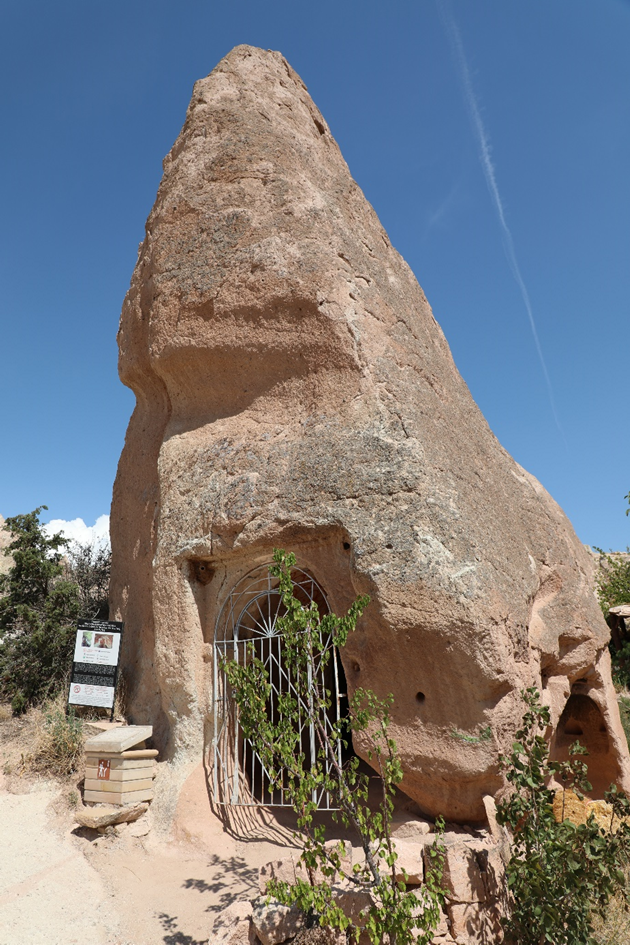General Information
Plan Description:
Dated to the Middle Byzantine period, the church extends along an east-west axis and is constructed with a single-nave plan. The structure comprises a square-planned narthex, a rectangular naos, an apse with a rounded arch both internally and externally on the eastern façade of the naos, as well as additional spaces located to the north and on the northern façade of the apse (Sarı, 2021: 26).
Exterior Description:
Situated on the southern slope of Kızılçukur Valley, all façades of the structure remain visible today. The entrance to the church is provided through a round-arched doorway framed within a rectangular border on the western façade. The door is noted for its iron grilles, while a niche, believed to have been added later, is present on the western slope (Photo 1).
Interior Description:
The square-planned narthex is covered with a barrel vault. On the northern façade, there is an arcosolium-style tomb with a round arch. Traces of a painted panel are visible on the southern façade.
The rectangular-plan naos is constructed in a longitudinal single-nave arrangement and is also covered with a barrel vault. The floor is simple and unadorned. On the northern side of the naos, there is an adjoining rectangular annex covered with a flat ceiling. This annex features a round-arched niche on its northern façade and arcosolium-style tombs on both its eastern and western sides. The eastern and western façades of this annex exhibit a plain design.
The apse section on the eastern façade is accessed by descending a low step due to the difference in elevation. The round-arched apse is covered with a semi-dome. The drum of the dome contains three round-arched, rectangular niches positioned on the eastern, northern, and southern sides. A square-planned window opening is located diagonally across from the niche on the southern side.
To the north of the apse, there is a rectangular annex. This space is covered with a flat ceiling and contains a rectangular niche resembling an apse on its northern façade, flanked by two triangular-arched rectangular niches. The eastern and western walls of the annex are designed with simplicity.
Decoration Description:
The interior decorations consist of red ochre and wall paintings applied over a white plaster base. The vault of the narthex features swirling floral branches painted in red ochre. At the center of the vault, a cross motif formed by the combination of black-painted squares and lozenge shapes stands out.
The barrel vault covering the naos is adorned with motifs of red grape clusters, white swirling branches, and acanthus flowers set against a yellow background. At the center of the vault, a cross motif created by the fusion of circular and lozenge shapes in black paint is enclosed within a chain-like sequence of interconnected medallions. These medallions contain representations of the Maltese cross, surrounded by peacock feather designs. Small red and black dots fill the spaces between the motifs, enhancing the details.
On the arch pediment of the vault, a depiction of Christ on the Cross is accompanied by figures of the Virgin Mary and John the Baptist. On the left side, Saint Simeon the Stylite is portrayed, with the Virgin Mary in the center and John the Baptist on the right. The entrance wall of the naos features four figures: Saints Damian, Cosmas, Panteleimon, and Saint Anne. The northern and southern walls each contain six figures, forming a total of twelve apostle representations. In the apse dome, a depiction of the Virgin Mary and Christ Child, along with the archangels Michael and Gabriel, is prominent. This scene is embellished with motifs of flower buds, pomegranates, and floral branches in yellow, red, and black. The center of the dome contains relief-carved details (Sarı, 2021: 27).
"Üzümü Church is not the most significant example of a Byzantine church in Cappadocia, yet with its distinctive tonality, geographical setting, and historical evolution, it undoubtedly represents an important heritage for the region. The church contains plaster-based murals requiring preservation. The historical graffiti on the walls of Üzümü Church provides significant testimony to the past. Various Greek inscriptions from the 8th–9th centuries AD, alongside depictions of horses, saints, and Arabic graffiti, can be observed" (Taniguchi, 2016: 40).
© 2025 Digital Cappadocia. All rights reserved. Unauthorized use of this content is prohibited.
How to get there?
Bahçelievler, 50650 Ortahisar/Ürgüp/Nevşehir

